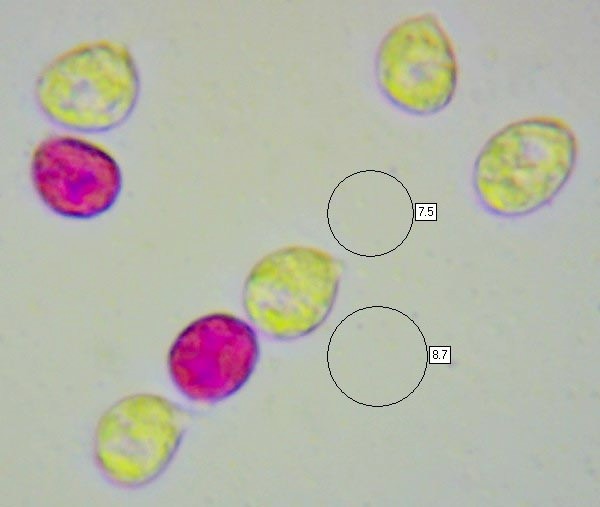Megacollybia platyphylla (Pers.) Kotl. & Pouzar - Whitelaced Shank
Phylum: Basidiomycota - Class: Agaricomycetes - Order: Agaricales - Family: Tricholomataceae
Distribution - Taxonomic History - Etymology - Identification - Culinary Notes - Reference Sources
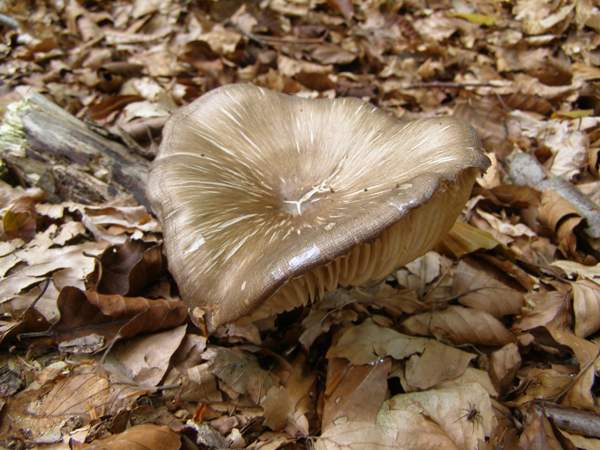
With a dark cap covering pallid gills, this is another tricky species to identify in situ, but its identity is at once betrayed if you excavate the base of the stem. The Whitelaced Shank has white... well, 'laces' is actually quite a good description for the stringy mycelial fibres that extend from the stem base for some considerable distance into the substrate timber or wood-rich humus of the forest floor. (In the picture below, the white 'laces' are clearly visible.)
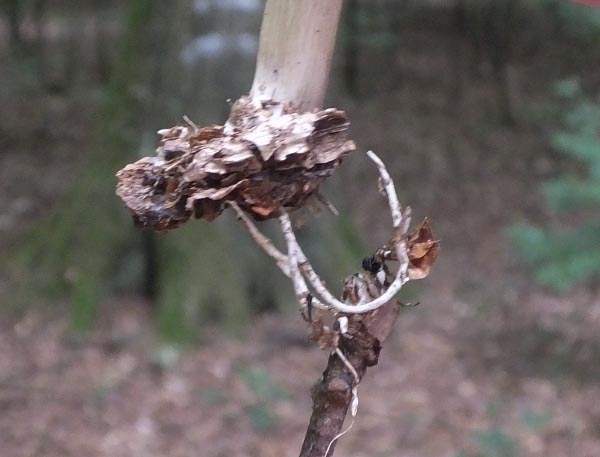
Distribution
In Britain and Ireland the Whitelaced Shank is widespread and common, particularly in the south. This woodland mushroom occurs also throughout most of mainland Europe and is also recorded in parts of Russia. This species was until recently thought to occur in parts of North America, but the USA specimens have now been shown to be non-co-specific with Megacollybia platyphylla and have been given species status.
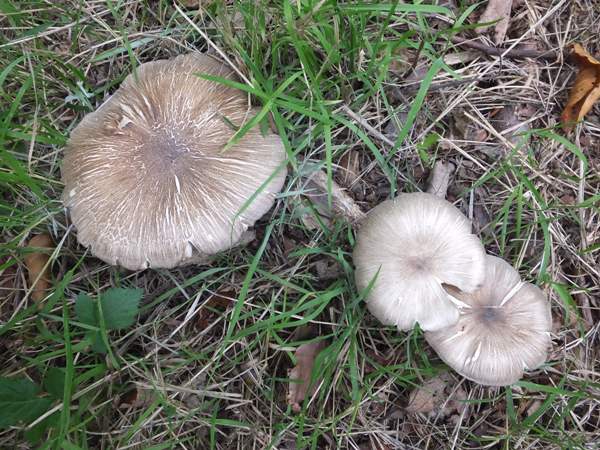
Taxonomic history
This saprobic fungus was described scientifically in 1796 by Christiaan Hendrik Persoon, who established its basionym when he gave it the binomial scientific name Agaricus platyphyllus. (In the early years of fungal taxonomy most of the gilled mushrooms were included initially in the genus Agaricus, the contents of which has since largely been redistributed across several newer genera.) In 1972 Czech mycologists František Kotlaba and Zdeněk Pouzar reclassified this species as Megacollybia platyphylla, which is its currently-accepted scientific name.
Synonyms of Megacollybia platyphylla include Agaricus grammocephalus Bull., Agaricus platyphyllus Pers., Agaricus repens Fr., Collybia platyphylla (Pers.) P. Kumm., Collybia grammocephala (Bull.) Quél., Agaricus tenuiceps Cooke & Massee, Tricholoma tenuiceps (Cooke & Massee) Massee, Tricholomopsis platyphylla (Pers.) Singer, and Oudemansiella platyphylla (Pers.) M.M. Moser.
This is the only species in the genus Megacollybia that is recorded from Britain, and it is the type species of that genus.
Etymology
The genus name Megacollybia come from Mega- meaning large, and -collybia meaning coins or coin-shaped, and so by implication these are larger than the coin-shaped fungi found in the genus Collybia.
Incidentally, several of the more common species that were for many years comfortably settled in the Collybia genus have recently been transferred to the genera Gymnopus and Rhodocollybia. See, for example, Gymnopus peronatus, the Wood Woollyfoot, and Rhodocollybia butyracea, Butter Cap (also commonly called Greasy Toughshank).
The specific epithet platyphylla comes from platy- meaning wide and -phylla meaning leaves (or gills in this case).
Identification guide
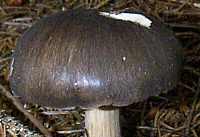 |
Cap6 to 14cm across; convex, not flattening completely but often developing a slight central depression with a small umbo; smooth and dry; various shades of grey-brown with radial streaks. In dry weather the caps of this mushroom sometimes split radially at the margins. |
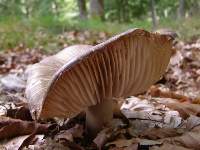 |
GillsSinuate or adnexed to stem; white, turning cream with age; crowded and very broad (platyphylla means literally 'broad leaves'). On older species the gills become irregularly wavy. |
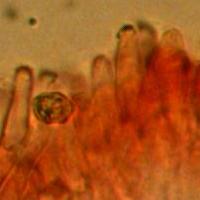 |
CheilocystidiaThe gill-edge cystidia are clavate (club-shaped). |
 |
Stem5 to 15cm long and 0.6 to 1cm dia.; base often rooting and with long white rhizomorphs (see left) attached; white, covered in grey-brown fibrils, paler at apex; no ring. |
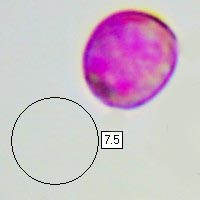 |
SporesBroadly ellipsoidal, smooth, 7-10 x 6-8.5μm; inamyloid. Spore printWhite. |
Odour/taste |
Not significant. |
Habitat & Ecological role |
Megacollybia platyphylla is a saprobic mushroom (feeding on rotting wood and other organic vegetation); it can occur either solitarily or in small groups on and near deciduous hardwood trunks, branches or woody debris (less commonly on conifer timber), or arising from the forest floor from from buried wood. |
Season |
June to November in Britain and Ireland. |
Similar species |
Melanoleuca polioleuca, the Common Cavalier, is similar but grows on soil rather than on wood;it has warty spores. (More than thirty species in the Melanoleuca genus are recorded from Britain and Ireland, and most have brownish caps and white gills; separating them is a task for specialists.) |
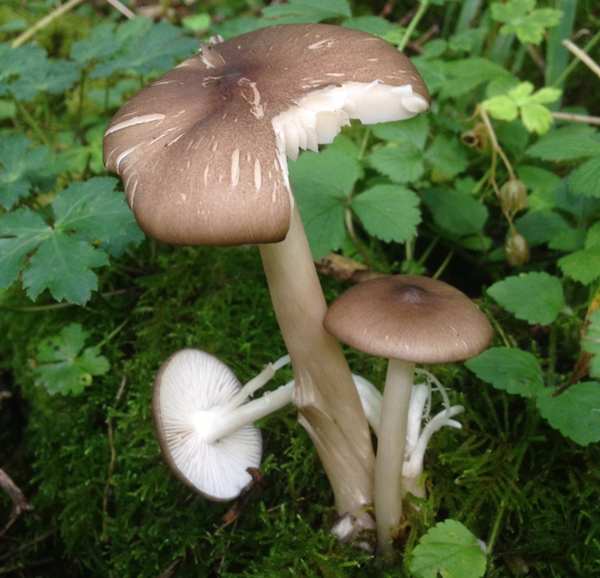
Culinary notes
There are conflicting reports as to whether Megacollybia platyphylla is edible and reports that at least some people have been sick after eating it; I suggest, therefore, you consider them as for looking, not for cooking.
Reference Sources
Fascinated by Fungi, 2nd Edition, Pat O'Reilly 2016, reprinted by Coch-y-bonddu Books in 2022.
Kuo, M. (2010). The genus Megacollybia, at MushroomExpert.Com
British Mycological Society, English Names for Fungi.
Dictionary of the Fungi; Paul M. Kirk, Paul F. Cannon, David W. Minter and J. A. Stalpers; CABI, 2008
Taxonomic history and synonym information on these pages is drawn from many sources but in particular from the British Mycological Society's GB Checklist of Fungi.
Acknowledgements
This page includes pictures kindly contributed by Simon Harding and Richard Shotbolt.
Fascinated by Fungi. Back by popular demand, Pat O'Reilly's best-selling 450-page hardback book is available now. The latest second edition was republished with a sparkling new cover design in September 2022 by Coch-y-Bonddu Books. Full details and copies are available from the publisher's online bookshop...
